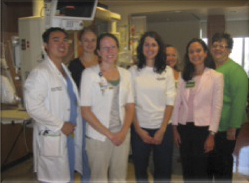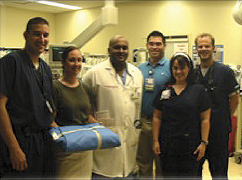 Click to Print Adobe PDF
Click to Print Adobe PDF
Winter 2010 - Vol.5, No.4
The Pharmacist's Role on the Trauma Team
Jennifer Costello, Pharm.D., BCPS and
Wichitah Leng, Pharm.D.
Lancaster General Health
|
 |
 |
INTRODUCTION
The advancement of pharmacy practice over the past several decades has broadened the role of clinical pharmacists, and they have become integral members of the healthcare team. Currently, the typical pathway to becoming a clinical pharmacist in critical care or emergency medicine involves extensive education with the attainment of a Doctor of Pharmacy Degree (Pharm.D.) and completion of one to two years of a postdoctoral residency. Further optional certification is available as a Board Certified Pharmacotherapy Specialist (BCPS), a certification that designates specialized experience and skills in clinical pharmacy practice. 5
Clinical pharmacists promote the safe and efficacious use of medications. Evidence indicates that the involvement of clinical pharmacists increases the safe use of medications and helps to decrease the costs of drug therapy. An estimated one in five US level I and II trauma centers offer pharmacy services during trauma resuscitation.1 In this article we will discuss in more detail the role of clinical pharmacists in the emergency department and critical care settings, as it relates to the continuum of care of trauma patients.
CLINICAL PHARMACY PRACTICE
Traditionally, the pharmacy department was located in one location and provided primarily a dispensing function. Over the last few decades, as pharmacy practice has continued to progress, suitably trained pharmacists are increasingly involved in many aspects of pharmacy-related patient care. They particularly contribute to the medication decision pathway, which involves collaborating with physicians on rounds and providing medication information to all health care providers. Other clinical activities include pharmacokinetic dosing of medications, medication dosing protocols, evaluating appropriateness of drug regimens, ensuring safe use of medications, administering immunizations, and serving as a drug information resource.
At LGH today, pharmacists are decentralized and integrated throughout the hospital, working closely with providers from various disciplines. Currently, clinical pharmacists are members of diverse teams with specialties in internal medicine, family medicine, cardiology, infectious disease, pediatrics, medication use safety, critical care, and emergency medicine.
TRAUMA/EMERGENCY DEPARTMENT CLINICAL PHARMACISTS
Wichitah P. Leng, Pharm. D. is the first emergency department (ED) clinical pharmacist at Lancaster General Health, establishing a pharmacy presence in the ED here in early 2009. Dr. Leng has developed the practice site by integrating his previous experiences at other institutions with insights gained from shadowing and seeking knowledge from those more established in the field. The ED clinical pharmacist’s work station is located in the main ED, providing optimal pharmacist accessibility and interaction with nurses, doctors and patients. Dr. Leng obtains medication histories and allergy information, and offers counseling to patients. He also analyzes the inventory of floor stock medications for appropriateness and feasibility. An example of his interface with the trauma service involves the medication mannitol, used for severe head injuries. Mannitol must be stored consistently near 70 degrees Fahrenheit to avoid formation of crystals in the solution. Dr. Leng recently facilitated the ED’s ability to stock mannitol, thus decreasing the time to treatment by eliminating the need for the pharmacy to deliver it, and also thereby avoiding the potential for crystals to form. He works closely with case management and social work to assist in obtaining medications for outpatients. He also offers an elective rotation in emergency medicine to pharmacy students who are in their final year of school at Pennsylvania pharmacy colleges and universities. The LGH Pharmacy Department also includes three, first-year post-doctorate pharmacy practice residents (PGY1). He offers an advanced rotation in emergency medicine for these PGY1 residents as well as for second-year residents from the Lebanon VA Medical Center.
Jennifer Costello, Pharm.D., BCPS has been a clinical pharmacist practicing primarily in the trauma-neuro unit. She has been involved with other related services at Lancaster General Health, such as management of pain, for more than 7 years. Her involvement has significantly increased beyond the daily rounds, including the development of policies, protocols and order sets pertaining to critical care medications. For example, she worked to standardize dosing for recombinant factor VIIa to provide the lowest effective dose for patients who are prescribed this agent for off-label use to treat life-threatening hemorrhage. She also developed a protocol to monitor triglycerides in patients receiving infusions of propofol. While participating in daily rounds, she uses evidence-based medicine to provide recommendations that optimize drug regimens, and focus on preventing potential adverse drug events. Dr. Costello is involved in nursing education and regularly presents at trauma conferences and journal clubs. She also precepts PGY1 residents and pharmacy students providing a critical care rotation
THE CONTINUUM OF PHARMACY CARE FOR THE TRAUMA PATIENT
Trauma patients are unique as they are subject to numerous mechanisms of injury as well as being of varying ages, genders, and having diverse comorbidities. A trauma patient may present to the ED in the category of stable trauma, trauma alert, or a higher-level Code T. When patients first present, Dr. Leng responds to trauma codes to provide pharmacy support. His activities include listening to the report, assisting in obtaining patient allergies and medication histories, and retrieving medications from Pyxis, medication boxes, or code trays. Leng also expedites the ordering and delivery of medications that must be sent from the pharmacy. He verifies weight based medications for pediatric patients and provides recommendations for antibiotics, immunizations, sedatives, analgesics, and other commonly used medications during resuscitation.
Once the patient is transferred to the trauma neuro unit (TNU), Dr. Costello assumes responsibility for the pharmacy services in the continuum of care. She participates in daily trauma rounds, provides recommendations to optimize medicine regimens, obtains medication histories and allergy information that was unable to be obtained in the ED, and serves as a primary drug information resource. She also monitors drug use by reviewing pertinent lab results and tests. Medication topics that are commonly encountered in the TNU include sedation, analgesia, vasoactive agents, antibiotics, alcohol withdrawal, seizure prophylaxis, stress ulcer prophylaxis, and DVT prophylaxis.
IMPACT OF CLINICAL PHARMACY SERVICES
A study by Kopp and colleagues looked at the cost implications and potential adverse events prevented by interventions of a critical care pharmacist.2 A total of 129 interventions were documented over 4.5 months, and the majority were found to have prevented potential adverse drug events (ADE). Other interventions led to either cost savings or addressed preventable or nonpreventable ADEs. The most common types of interventions involved providing information about drugs (40%) and recommendations for alternative therapy (26%). Consistent with the daily activities of clinical pharmacists, patient care rounds and chart-reviews were associated with the greatest number of interventions and the greatest potential for reducing costs.2
Brophy and colleagues assessed the impact of a clinical pharmacist’s participation on the management of posttraumatic seizure prophylaxis in a neuroscience intensive care unit. 3 They showed that with the involvement of a clinical pharmacist on rounds, the duration of phenytoin therapy for each patient was reduced in half, to one that is more consistent with recommendations in the literature. When pharmacists monitored therapy, the blood levels for phenytoin were more likely to have been drawn at the appropriate time. They concluded that clinical pharmacists are integral members of the patient care team, and their participation affects patient care and outcomes positively.3
CONCLUSIONS
Clinical pharmacists have advanced experiences and skill sets, primarily through the completion of post-graduate pharmacy practice residencies; they have specialty certifications as Board Certified Pharmacotherapy Specialists; and they work directly with providers to offer pharmacy services.4 Lancaster General Health has a very strong clinical pharmacy department; its work provides a long-lasting impact on patient care by ensuring safe and efficacious use of medications, and continual advancement for best practices. The trauma patient provides a unique set of challenges due to the extreme variation in circumstances of the affected population as well as any underlying comorbidities. The ED clinical pharmacist provides the initial pharmacy presence at bedside. The treatment goal for the trauma patient transitions from resuscitation in the trauma bay to medical stabilization in the trauma-neuro unit. In the continuum of pharmacy care, responsibilities for providing clinical pharmacy services shifts to the critical care clinical pharmacist. Published studies have shown that the involvement of a clinical pharmacist in the care of inpatients shortens length of treatment, reduces the incidence of adverse drug events, fosters concise medication reconciliation, and improves overall outcomes.2,3,4


REFERENCES
1. McDonald EJ, Elliott LR, and Hale LS. A Survey of Pharmacist Participation in Trauma Resuscitation. Proceeding of the 5th Annual GRASP Symposium. Wichita State University 2009;50-51.
2. Kopp BJ, Mrsan M, Erstad BL, and Duby JJ. Cost Implications of and Potential Adverse events prevented by interventions of a critical care pharmacist. Am J Health Syst Pharm Dec 1, 2007;64:2483-2487.
3. Brophy GM, Tesoro EP, Schrote GL, and Garnett WR. Pharmacist Impact on Posttraumatic Seizure Prophylaxis in Patients with Head Injury. Pharmacotherapy 2002; 22(2); 251-255.
4. Kaboli PJ, Hoth AB, McClimon BJ, and Schnipper JK. Clinical Pharmacists and Inpatient Medical Care. Arch Intern Med. 2006;166:955-965.
5. World Wide Web. BPS Board of Pharmacy Specialties. [Cited 2010 August 20th]. Accessed from http://www.bpsweb.org/certification/index.cfm